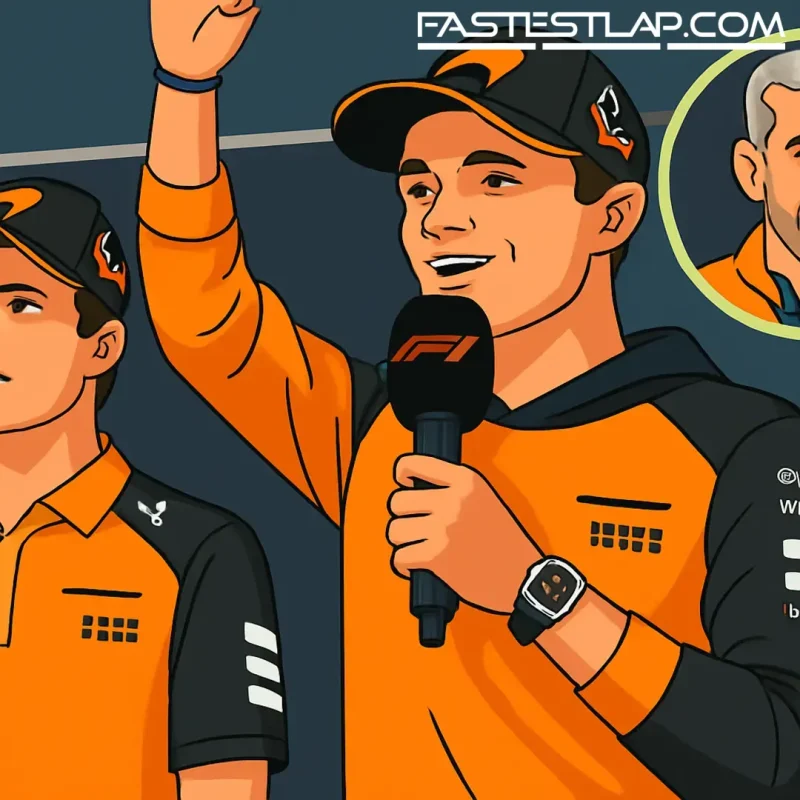McLaren won’t play favorites — unless the numbers make the call. That’s the line from Andrea Stella as the title fight tightens and the calendar runs out.
With five Grands Prix and two Sprints left, Max Verstappen has carved 64 points out of Oscar Piastri’s lead and is the one with the tailwind. Piastri still heads the standings with Lando Norris right there — the intra-garage gap narrowed to 14 points after Austin — but the pressure is now coming from behind in a way McLaren haven’t felt in months.
Asked if he’d pick a lane between his two drivers, Stella didn’t blink. Only “mathematics,” he said, will force McLaren to prioritize one over the other.
“The fact there are five races and two Sprints means we can also increase the gap to Max. That’s how I see things,” Stella told reporters in Austin. “We’ve got good tracks coming for our car, and there’s more to extract — from us and from the drivers. We look at the next five races as opportunities to increase the gap on Max.”
It’s the same stance McLaren have held all year: equal footing, let them race, manage the flashpoints. The team bristled after Norris and Piastri clashed wheels in Singapore at Turn 7 — “repercussions” was the word used in the aftermath — but the policy hasn’t changed. They’ll let them fight unless one of them is out of the hunt on paper.
“When it comes to having to make a call as to a driver, this will only be read by mathematics,” Stella said. “In 2007 and 2010 you go to the last race and it’s the third-placed driver who wins the championship. We’re not going to close the door, unless this is closed by mathematics.”
Strip away the corporate calm and it’s clear McLaren know exactly what they’re sitting on: two drivers capable of winning on pace, a car that’s on balance more versatile than Red Bull’s at this stage, and a heavyweight opponent who’s rediscovered his groove. The Sprint weekends are a double-edged sword in that equation. More points on offer, more chances to land a haymaker — and more chances to take one.
The Norris-Piastri dynamic has been remarkably clean for a title-contending pairing, but the edges are there. Norris, with more mileage and more podium scars, has been open about missed chances. Piastri, already a Grand Prix winner this year, is the one with the number next to his name that everyone else wants. And Verstappen? He doesn’t need an invitation when it comes to finishing sprints in the dark.
McLaren’s strategy posture is therefore simple, and ruthless by omission. They’ll maximize weekends, avoid tripping over themselves, and keep the toolbox open for team orders only if one side of the garage is mathematically out of play. That also protects the longer game: unity under stress. Nothing corrodes a title bid like an early, ill-judged call that locks one driver into a support role with too many variables still in motion.
There’s also a quiet confidence inside Woking about the run-in. Stella hinted there’s performance still to be unlocked, not just in updates but in execution — the sort of marginal gains that decide qualifying rows and undercut windows. If that’s true, and if both drivers keep their elbows sharp without stepping on each other’s toes, the team can force Verstappen to keep taking risks to close — and that’s when gaps can go up as well as down.
The calendar has a memory, and so does Stella. He’s not wrong invoking 2007 or 2010. Championships have a habit of twisting in the final act, often against the expected favorite. McLaren don’t want to be the storyline; they want to be the constant.
For now, the message is steady: no anointing, no drama, no early calls. Just two papaya cars free to race, and a calculator on standby. In a title fight this tight, that’s as bold as it gets.




